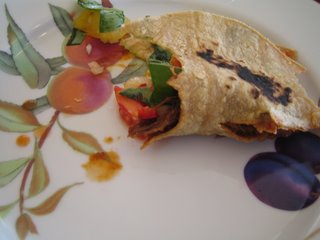Birria:
5 # hind quarter of goat
Marinade:
12 dried New Mexican chiles, seeded
6 ancho chiles, seeded
2 cloves
3 T sesame seeds, toasted
3 T pumpkin seeds, toasted
1 head garlic, seperated into cloves but unpeeled
1/4 C tablespoons cider vinegar
1 T ground cumin
12 black peppercorns
1 T salt
3 teaspoons sugar
Stock:
5 large heirloom tomatoes, roasted and diced
Juice of 2 limes
4 laurel leaves
1 T Mexican oregano
1 t salt
2 bay leaves
pinch ground canela (Mexican cinnamon)
Trim fat from meat and cut into 2 or three equal sized pieces and place in a large roasting pan.
For the marinade tear chiles into flat pieces and toast, pressing them against the hot surface, until they crack and blister; flip them and press down again. Transfer chiles to a large bowl and cover with boiling water; weight down with a plate to keep them submerged, and soak at least 30 minutes. Meanwhile, roast the garlic in the same griddle or skillet, turning frequently, until soft inside and blackened outside, about 15 minutes. Cool and peel. Drain chiles, reserving 3/4 cup soaking liquid; put chiles into a blender with garlic, cloves, sesame seeds, vinegar, cumin, lime, peppercorns or ground pepper, and salt. Blend until smooth; then strain. Remove 1/2 cup of mixture to a small bowl, and stir in the sugar; set aside to u se for the final glazing.
Marinate the meat and spread the rest of the chile paste thoroughly over the meat. Cover completely and refrigerate overnight.
Preheat the oven to 300 degrees. Use a deep wide roasting pan that has a tight lid. Put a roasting rack into the bottom of the pan (it must sit at least 1 inch above the bottom of the pan---if not, prop it up with ramekins or tin cans) Measure in 4 cups of water. Then lay the marinated meat onto the rack and spread any marinade remaining in the marinating pan or dish. Cut a double thickness of heavy-duty foil to cover the roasting pan; place the pan lid over, making sure the pan is covered as tightly as possible. Bake/steam 6-8 hours.
Remove the pan lid and foil; carefully remove the tender meat to a platter. Take out the rack; spoon the fat off the broth with a ladle. Measure out the broth into a 1-quart container; add water to equal 1 quart liquid if necessary, and pour into a saucepan. Puree the tomato in a blender and add it to the broth along with the oregano, cinnamon, and lime juice. Cover; simmer over medium-low heat 45 minutes. Season with salt.
Heat oven to 375 degrees. Remove meat from the bones, keeping pieces of meat as large as possible; add bones to simmering stock, and discard any excess fat. Set meat on a baking sheet; brush lightly with reserved chile paste glaze, and bake 10 minutes to set the glaze.
After 45 minutes of simmering, drain the stock into a serving bowl and add the meat. Adjust seasoning.
Enjoy with hot tortillas, diced onion, cilantro, lime juice, and hot sauce.
In mexico the Goat is wrapped in pencas de maguey (agave leaves) and barbecued in a pit, like they did a few years ago at Mariquita Farm near Monterey The next day put all leftover Birria in a stock pot and simmer over low heat until the stock reduces and concentrates into a thick "gravy".
The next day put all leftover Birria in a stock pot and simmer over low heat until the stock reduces and concentrates into a thick "gravy".
Make tacos and accompany with a Californian Springtime Salsa:
1/2 bunch fava greens, rough chopped
3 plump heirloom tomatoes
juice of 2 lime
1/2 small red onion, diced
1 jalapeno, minced
 It is silly to change this traditional recipe by using fava greens instead of cilantro, but we forgot to buy cilantro and we were excited to use the fava greens we bought from the farmers market. This is how recipes evolve and change over time. Actually, I don't think our "California Springtime Salsa" will really effect the future of cilantro's place on the table next to birria, but the fava greens sure made for a refreshing substitute.
It is silly to change this traditional recipe by using fava greens instead of cilantro, but we forgot to buy cilantro and we were excited to use the fava greens we bought from the farmers market. This is how recipes evolve and change over time. Actually, I don't think our "California Springtime Salsa" will really effect the future of cilantro's place on the table next to birria, but the fava greens sure made for a refreshing substitute.  The farmers that sold us the fava greens said that it is still way too early for fava beans, but we found some at the same market on the same day.They must have been grown indoors, said the fava green vendors at Knoll Farms, home of America's greatest fig. They may have been grown indoors, but that didn't stop us from enjoying then raw outdoors at a recent picnic in the park.
The farmers that sold us the fava greens said that it is still way too early for fava beans, but we found some at the same market on the same day.They must have been grown indoors, said the fava green vendors at Knoll Farms, home of America's greatest fig. They may have been grown indoors, but that didn't stop us from enjoying then raw outdoors at a recent picnic in the park.
Thursday, June 01, 2006
Slow Goat
Subscribe to:
Post Comments (Atom)






2 comments:
great in most every combination, tacos, tamales, taquitos, with sweet potato fries... my plate!
ed hardy clothes
discount nike running shoes
discount nike shoes
nike shox shoes
ed hardy outerwear
ed hardy womens
ed hardy womens jeans
cheap nike shoes
nike sports shoes
puma running shoes
puma sneakers
ed hardy bags
ed hardy winter boots
ed hardy t shirts
nike shoes kids
nike women shoes
nike running shoes
ed hardy womens shoes
ed hardy t shirts for men
ed hardy mens jeans
wholesale nike shoes
nike shoes
nike tn dollar
nike air max 90
nike air max 2009
nike air max 2010
nike air max tn
puma cat
ed hardy mens shoes
ed hardy womens hoodies
ed hardy mens tees
puma shoes
ed hardy clothing us
ed hardy clothing
ed hardy outerwear
ed hardy t shirts
ed hardy boots
ed hardy hoodies
cheap ed hardy
ed hardy clothes
cheap ed hardy clothing
ed hardy wholesale
ed hardy men’s
ed hardy women’s
ed hardy kid’s
Post a Comment